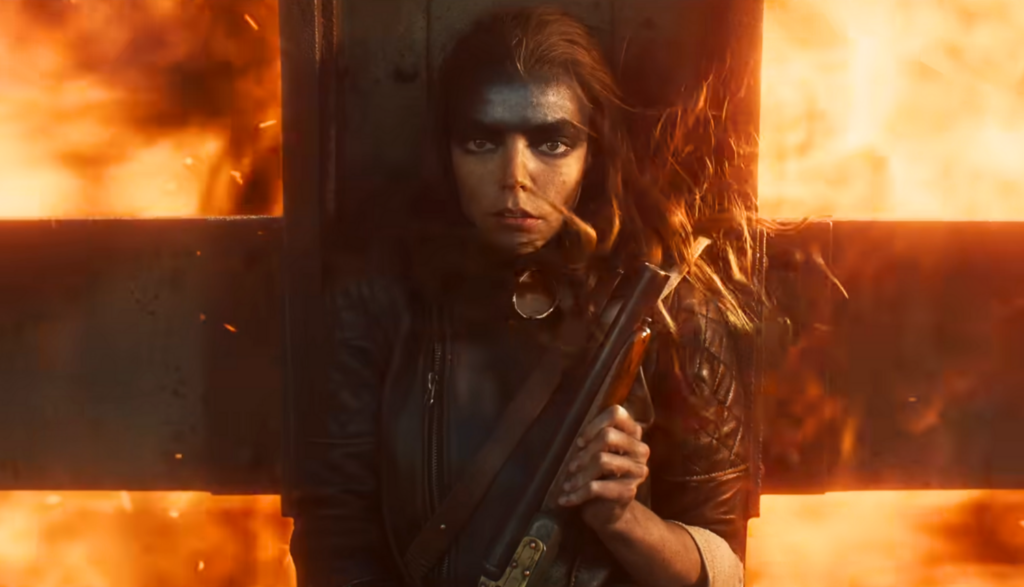
They call it the Wasteland. And that’s treating it kindly.
It’s home to rock, dust, ash, bone. The people who live there—hard survivors of cataclysm—wear the tatters of their own humanity around their shoulders. What little hope they stored away was long ago taken from them, ripped open like a carcass and picked at by buzzards.
Perhaps once, the land was green. Perhaps you could listen to water run unhindered, pick red fruit right from the tree. But no more. No more. Such places are history. Myth. Delusion.
Secret.
Furiosa lived in such a place—a place of green trees and cool streams, an Eden where hope still grows ripe and full. And people would do most anything to find it.
Well, a handful of raiders did find it—and they found Furiosa, too. They tied her up and threw her across a bike, hoping to use her as living proof of the hidden paradise. Furiosa’s mother tore after the kidnappers and snatched her beloved daughter away out of the enemy camp. Soon, on the back of a pilfered motorcycle, they were roaring back home.
The raiders, led by the warlord Dementor, tore after them—determined to reclaim their prize and, if possible, descend on Furiosa’s green garden like gas-reeking locusts. Soon Furiosa’s mother was dead and the girl herself was back in their hands.
But before she died, Furiosa’s mom placed a fruit seed in Furiosa’s hands. “Plant this seed,” she told the girl. “Protect the Green Place.”
And so Furiosa has.
She’s been with Dementus for years now—watching him preen and plunder and kill. She’s never spoken a word since her mother died. At first, he kept Furiosa in a cage. But Dementor has taken a shine to the girl, adopting her as his own and calling her, “My Little D.”
Furiosa bides her time. Waiting. Looking for an opportunity to find her way back to the green place.
Dementus’ upcoming meeting with another, rival warlord? The mysterious ruler of the Citadel, Immortan Joe?
It might be one more step toward home.
The Wasteland is not filled with a lot of great role models. Virtue is pretty relative, and showing too much kindness is a good way to get you killed. (Actually, Furiosa’s mother is living/dying proof of that—granting clemency to a fellow mother as she takes Furiosa out of Dementus’s camp. The other mom promptly rats the two out.)
But even here, even now, you see some people act with higher motives.
Naturally, Furiosa’s mom shows a mother’s instincts, risking her life repeatedly for her little girl. Other folks living in that “green place” seem to have retained a little more humanity than their Wasteland fellows, too.
But even in the Wasteland, not everyone’s a jerk. As an adult, Furiosa falls in with a driver named Praetorian Jack. He mentors and befriends her, promising to give Furiosa the skills she needs to survive and, ultimately, to take off on her own. Furiosa grows to trust Jack, and the man proves to be worthy of it—never asking her too many questions, but always supporting her as much as he can.
As for Furiosa, well, she’s suffered plenty in her short lifetime. The things she’s seen (and the things she’s done) leave an indelible mark. But as scarred as she might be, Furiosa shows unwavering loyalty to those who prove worthy of it. She rushes in to fight for those she loves, even when the odds seem hopeless, and the more prudent path would be away from the fight.
The various tribes that populate the Wasteland have, at times, embraced a near-shamanistic attitude toward the natural and man-made elements around them.
When the movie introduces us to Dementus, he’s in his tent, draped in a shawl almost as an old-school Sadducee might be. His attention, as is that of the tent’s other occupants, is turned toward a motorcycle: The History Man (an ancient-looking fellow whose skin is covered in tattooed words) recites the specifications of said motorcycle, almost as if it was some sort of mantra. In another scene, several men seem to bow reverently to a pile of discarded steering wheels.
Immortan Joe isn’t quite the quasi-divine figure he becomes in Mad Max: Fury Road, but he still inspires rabid devotion from his followers—blithely sending a man (called a War Boy) to his death, just to prove his loyalty. Those War Boys, incidentally, spray their mouths in chrome paint when they go all kamikaze (which is often)—again, a nod to their holy or near-holy regard in which they hold their machines. We also hear a reference to “holy motors.”
The residents of Furiosa’s Green Place turn away from man-made objects and instead cast what devotion they have upward. “The stars be with you,” they sometimes tell each other for good luck.
A narrator recites some notable wars in Earth’s past, broadly mentioning the “countless wars of religion and righteous belief.” Someone calls Furiosa the “darkest of angels; the fifth rider of the apocalypse.” We hear the phrase, “Hell and hallelujah!”
As was the case in Mad Max: Fury Road, Immortan Joe has, essentially, a harem. It’s populated by women draped in white (garments that sometimes expose thigh and midriff) and who are there, simply, to have sex with the warlord. (He’s hoping to father another heir.)
When Dementus and Immortan Joe meet as part of some Wasteland negotiations, Dementus brings along the child Furiosa, introducing her as being “untouched by man or disease.” Immortan Joe wants the girl to join that harem, believing that she’ll be a fine “breeder” when she grows up. Dementus initially tells Immortan Joe that his “daughter” is not for sale, but (thanks in part to Furiosa’s own machinations) she falls under the sway of the Citadel anyway. And while Immortan Joe seems only to be holding Furiosa for future use, his son, Rictus Erectus, seems to be interested in the child right now. He plays with her hair in one scene and forces her into a private meeting in another. (Furiosa escapes both encounters.)
Residents of the Green Place show deep love for one another not by kissing, but by pressing their foreheads together. Furiosa and her mother engage in this gesture. Furiosa and Praetorian Jack do, as well. And Furiosa’s mother performs the gesture with another woman: This could be just a sign of deep friendship, but it could also be interpreted as a nod to a same-sex romance.
The headquarters of a Wasteland boss features a painting filled with bare-breasted women. (He’s reproducing what would appear to be a romantic-era painting, of which he has a small print of.) A motorcycle is adorned with the head and torso of an anatomically accurate female mannequin. Men go without shirts. Dementor often wears an elaborate codpiece. At one juncture, he also chains a teddy bear around his loin area (which someone removes). Immortan Joe’s other son is named Scrotus.
There’s a lot to cover here, so we’ll not get too descriptive.
A man is chained to several motorcycles, which then pull the guy apart. Another has his neck severely cut in a crash: The man bleeds his life away as dogs lap up the blood and lick his wounds. Someone is executed by being tethered to the back of a bike via a chain; he’s forced to run until he can run no more, after which he’s dragged in a circle for hours. (He’s quite dead by then.) We see someone serve as living fertilizer for a tree—planted, apparently, right on the guy’s groin. A character is essentially crucified. Wasteland inhabitants surround a man who crashed in the desert: If the fallen man isn’t dead already, it’s clear he soon will be. Another character gets gobbled up by the desert itself, being sucked into a pit.
We do learn how Furiosa lost her arm—and we see the appendage dangle from a chain, gore dripping from the lost limb. After losing it, she ultimately finds herself in a nightmarish cavern: Her wound is covered in maggots—who are also having a field day with the other arms, legs and dead bodies crammed into the space. Live residents encourage Furiosa to stay—telling the woman that she can find “peace” there.
A man is skewered in the head with a massive dart. A War Boy sports a small arrow in his shaved head (and he appears not to mind). A dog trots around with a disembodied foot in its mouth. A tire shreds somebody’s arm. A descending portcullis smashes a car (and presumably those inside). Claws and chains snatch up motorcycles and their riders, sending many of the latter falling to their doom. A horse is butchered, and its head is strapped to a motorcycle. Someone purposely leaps to his death, taking an explosive with him and blowing up several not-so-innocent watchers.
Someone suffers a nasty looking wound on the back. A male characters’ nipples are ripped off. (Another character has a chain connected to his chest area.)
Dozens of people are killed via guns. (We often see the moment of impact and/or the resulting head wounds.) Many others die in fiery explosions. Still others get crushed by cars, trucks and war machines. Paragliders and ultralight fliers are harpooned and dragged into the ground or into spinning bits of machinery. Spines are somehow used as whips. A prominent character walks around with a vacant eye socket. So many vehicles crash. So many people die in said vehicles.
The word “b–tard” is used twice, and we hear the British profanity “b-llocks” once (along with the anatomical word “testes”). The word “p-ss” is used several times, always referring to the actual substance. We hear a crude term for breasts as well. God’s name is abused once.
Dementus drinks from a flask.
A fighter holds a jar of his own urine, which he apparently uses to cool down a war machine’s radiators. (He even apparently has the title of “p-ss boy.”) Furiosa shakes a bottle of her own urine in someone’s face. An “organic mechanic” whips up delicacies made from human blood and, possibly, flesh.
“You can never balance the scales of suffering,” Dementor tells Furiosa. No matter: She’s sure going to try.
Listen, all Mad Max movies are plenty bleak. In each installment, creator and director George Miller reliably spoons us a broth of dust and blood, and he shows us a world gone—well, mad. That’s really the point: Some humans may have survived the apocalypse, but humanity is mostly dead.
But not entirely.
In most Mad Max films—as bloody and carnage-driven as they are—we see signs of virtue and hope and love. Mad Max: Fury Road, for all its excesses, came with some interesting spiritual wrinkles and a quest for redemption. Does that necessarily redeem all the blood and gore that splashes on the way? Maybe not. But at least we feel like the movie had a purpose beyond the ook. It, like Furiosa’s drive toward home in Fury Road, was taking us to a better place.
But in the prequel Furiosa: A Mad Max Saga, we’re literally and figuratively driving away from that comparative paradise and into the Wasteland. And the waste we encounter can feel pretty oppressive.
Listen, for Mad Max fans, all the ingredients are here. The action sequences are still great, if not spectacular. The world of Mad Max has never felt so convincingly grimy. Chris Hemsworth, playing Dementus, swaggers around something like a post-apocalyptic Jack Sparrow, managing to be both a bit ludicrous and reliably evil.
But without a redemptive carrot to chase in this movie, the story can feel sluggish, and the violence sinks into inescapable sadism. And when Dementus tells Furiosa that the two of them are cut from the same cloth, you buy it. She is as her world made her: cruel.


Paul Asay has been part of the Plugged In staff since 2007, watching and reviewing roughly 15 quintillion movies and television shows. He’s written for a number of other publications, too, including Time, The Washington Post and Christianity Today. The author of several books, Paul loves to find spirituality in unexpected places, including popular entertainment, and he loves all things superhero. His vices include James Bond films, Mountain Dew and terrible B-grade movies. He’s married, has two children and a neurotic dog, runs marathons on occasion and hopes to someday own his own tuxedo. Feel free to follow him on Twitter @AsayPaul.